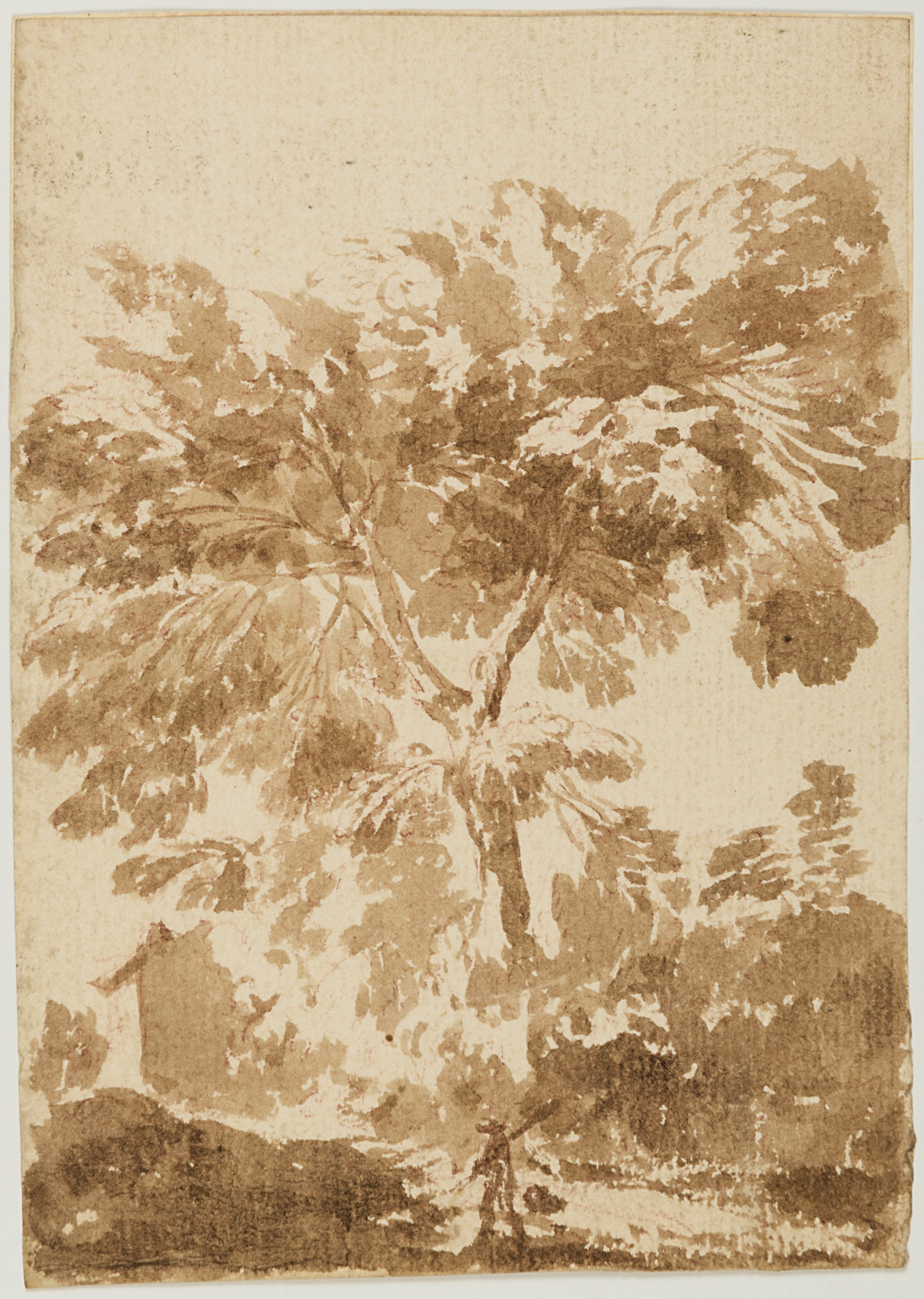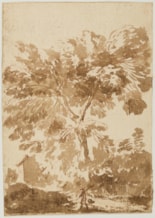Alessio DE MARCHIS
(Naples 1684 - Perugia 1752)
Landscape with a Traveller by a Tree, a House Beyond
Sold
Pen and brown ink, over traces of an underdrawing in red chalk.
191 x 134 mm. (7 1/2 x 5 1/4 in.)
191 x 134 mm. (7 1/2 x 5 1/4 in.)
As Marco Chiarini describes the Alessio de Marchis's influences as a draughtsman, ‘The most varied experiences seem to constitute the basis of Alessio’s stylistic formation. He grafts onto the [Salvator] Rosa component clear inspiration from the works of a number of Dutch “Italianizing” artists, combined with motifs, possibly derived through their work, which seem to go back to Claude, but above all…his fantasy was affected by the later and more romantic phase of [Gaspard] Dughet’s style…the Dughet of the late landscapes, light in color tones, and of studied and constructed compositions, a prelude, in fact, to eighteenth-century taste...’2. Chiarini further notes that, ‘when Alessio’s observation of nature is at its most personal and subjective, his art occasionally assumes an authentic, individualist character…His drawings often reveal a very subtle treatment of light and an ability at evoking vast landscapes punctuated with ruins which…are caught in unexpected light effects or emerging from misty distances.’
Among stylistically comparable drawings by Alessio de Marchis are landscape sketches in the Albertina in Vienna, the British Museum in London, the Statens Museum for Kunst in Copenhagen and at Christ Church in Oxford.
Among stylistically comparable drawings by Alessio de Marchis are landscape sketches in the Albertina in Vienna, the British Museum in London, the Statens Museum for Kunst in Copenhagen and at Christ Church in Oxford.
Born in Naples, the landscape painter Alessio de Marchis was mainly active in Rome and Urbino. (He remained proud of his Neapolitan heritage, however, and often added his birthplace to his signature on his drawings.) De Marchis was much influenced by the landscapes of Salvator Rosa and Claude Lorrain, and as a young artist worked as a fresco painter in the palaces of the Albani and Ruspoli families in Rome. In his desire to paint fire more accurately, he one day set fire to a haystack in order to paint the flames. The fire caused serious damage, and for this act the artist was imprisoned and sentenced to several years as a galley slave. He was eventually pardoned by Pope Clement XI, who presented him with several commissions for landscape paintings and seascapes, although the artist appears never to have returned to Rome. De Marchis worked at the Palazzo Albani in Urbino, and seems to have spent the remainder of his career in the Marches and Umbria. Among his important later commissions were the decoration of the Palazzo Anselmi and the chapel of the Collegio Gregoriano in Perugia, where he died in August 1752.
In a pioneering article on Alessio de Marchis’s drawings, published in 1967, Marco Chiarini has noted of the artist that ‘his technique is usually very easily recognizable. He almost always uses red chalk…and thick brown washes of a burnt Siena tonality, with very pronounced contrasts of light and shade, achieved by allowing the paper to show through to form the highlights, thus underlining the somewhat fantastic and often unreal appearance of the subject. The drawings are executed with great speed as if they were improvisations on the spur of the moment, possibly not even drawn after nature but thought out in the studio with reminiscences of works by other artists…Alessio’s production must have been very prolific, judging from an even very incomplete survey of the material existing in public and private collections.’
Landscape drawings by de Marchis – most of which have the appearance of finished works intended for sale - are today in the collections of the Museo Civico in Bassano, the Musée des Beaux-Arts et d’Archéologie in Besançon, the Kupferstichkabinett in Dresden, the Uffizi in Florence, the British Museum and the Courtauld Gallery in London, the Pierpont Morgan Library in New York, the Christ Church Picture Gallery in Oxford, the Louvre in Paris, the Istituto Nazionale per la Grafica in Rome, the Albertina in Vienna, the Royal Library at Windsor Castle, and elsewhere.
In a pioneering article on Alessio de Marchis’s drawings, published in 1967, Marco Chiarini has noted of the artist that ‘his technique is usually very easily recognizable. He almost always uses red chalk…and thick brown washes of a burnt Siena tonality, with very pronounced contrasts of light and shade, achieved by allowing the paper to show through to form the highlights, thus underlining the somewhat fantastic and often unreal appearance of the subject. The drawings are executed with great speed as if they were improvisations on the spur of the moment, possibly not even drawn after nature but thought out in the studio with reminiscences of works by other artists…Alessio’s production must have been very prolific, judging from an even very incomplete survey of the material existing in public and private collections.’
Landscape drawings by de Marchis – most of which have the appearance of finished works intended for sale - are today in the collections of the Museo Civico in Bassano, the Musée des Beaux-Arts et d’Archéologie in Besançon, the Kupferstichkabinett in Dresden, the Uffizi in Florence, the British Museum and the Courtauld Gallery in London, the Pierpont Morgan Library in New York, the Christ Church Picture Gallery in Oxford, the Louvre in Paris, the Istituto Nazionale per la Grafica in Rome, the Albertina in Vienna, the Royal Library at Windsor Castle, and elsewhere.
Provenance
Giancarlo Sestieri, Rome.
Literature
Giancarlo Sestieri, Roma. Paesaggi, vedute e costumi: Dipinti e Disegni, exhibition catalogue, Rome, 1983, unpaginated, no.59b (as Albero con viandante e casupola), illustrated in the Introduction.
Exhibition
Rome, Palazzo Borghese, Roma. Paesaggi, vedute e costumi: Dipinti e Disegni, 1983, no.59b.




